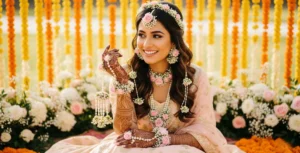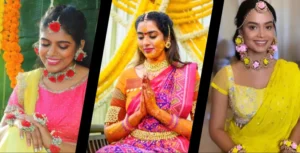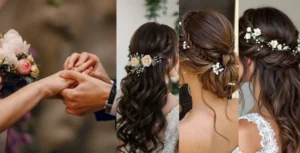Weddings in South India are vibrant, happy, and full of deeply cherished customs. These celebrations of the union of two families combine joyful traditions with profound cultural customs.
Every aspect of the wedding has meaning, from the dawn of Muhurtham to the emotional moment of tying the Mangalsutra.
This post will guide you through the many South Indian wedding traditions: From Muhurtham to Mangalsutratraditions and rituals that showcase the rich culture and lively celebrations that unite people at South Indian weddings, making them one of a kind.
South Indian Wedding Traditions
Muhurtham: The Fortunate Start
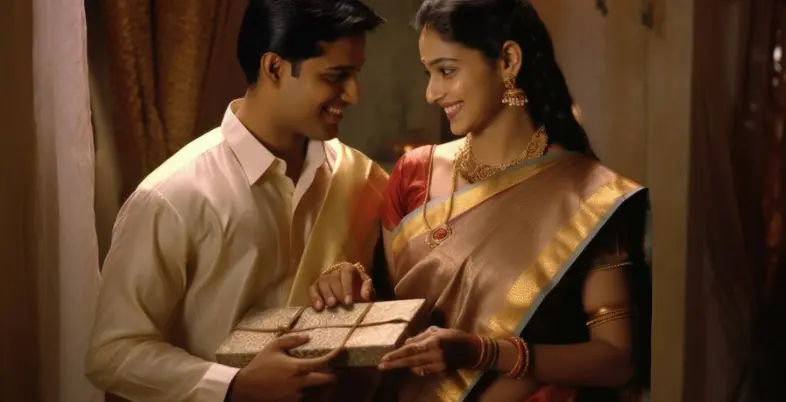
The wedding journey begins with the Muhurtham, a fortunate time selected for the wedding based on the horoscopes of the bride and groom.
This time is determined by a priest who consults astrological charts to ensure that the wedding occurs under the most favorable celestial conditions. The selection of the Muhurtham underscores the importance of divine blessings and auspicious beginnings in South Indian culture.
Pre-Wedding Rituals
Kashi Yatra
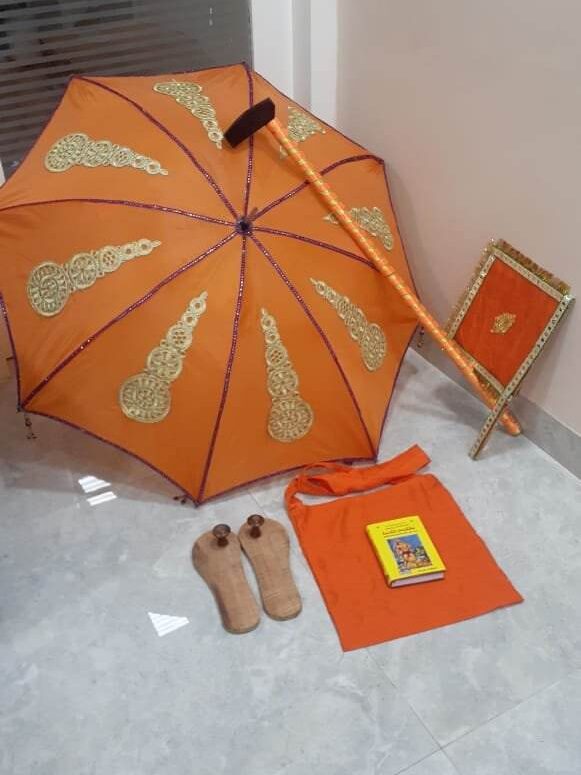
One of the most engaging pre-wedding rituals is the Kashi Yatra. This ritual, steeped in humor and symbolism, marks the groom’s symbolic journey towards a life of asceticism. The groom pretends to renounce worldly pleasures and head towards Kashi (Varanasi) to live a life of spiritual contemplation.
However, the bride’s father intercepts him, persuading him to embrace married life instead. This playful ceremony signifies the groom’s readiness to transition from bachelorhood to a life of familial responsibilities.
Nischay Tamulam and Sumangali Prarthanai
In Kannada and Tamil weddings, the pre-wedding period involves ceremonies like Nischay Tamulam (engagement) and Sumangali Prarthanai (seeking blessings from married women). The Nischay Tamulam involves the formal announcement of the engagement and the exchange of gifts.
Sumangali Prarthanai is a ritual where the bride seeks blessings from Sumangali women (women who have led a fulfilled married life) to ensure a happy and prosperous marriage.
The Main Wedding Day
Mangala Snanam
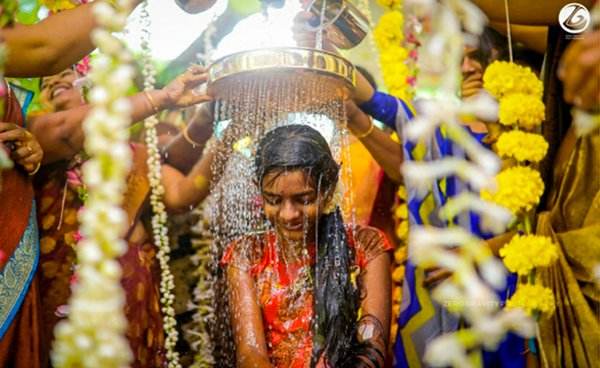
The wedding day begins with the Mangala Snanam, a purification ritual. Relatives and friends apply a paste of turmeric, oil, and kumkum to the bride and groom at their respective homes. This is followed by a purifying bath, symbolizing the cleansing of the body and soul to prepare for the sacred wedding rituals.
Read more– Mangala Snanam Jalleda: A Sacred Wedding Tradition
Kanyadana
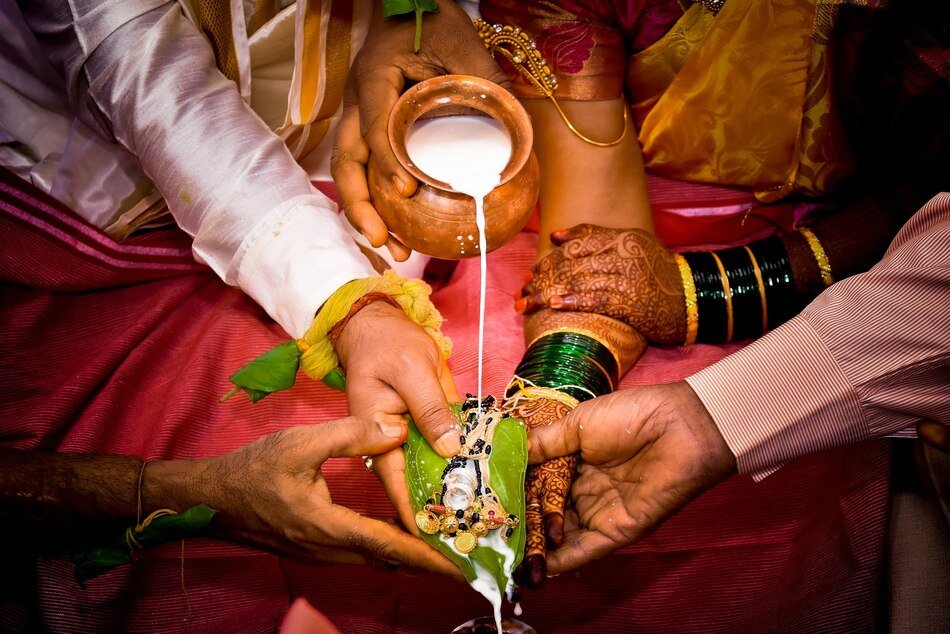
Kanyadana, or the giving away of the bride, is a deeply emotional ceremony. The bride’s father places her hands into the groom’s, entrusting her to his care.
This act represents the transition of the bride from her parental home to her marital home, symbolizing the transfer of responsibility and blessings from her parents to her husband. This ceremony highlights the significance of parental blessings and the sanctity of marriage.
Oonjal/Swing Ceremony
The Oonjal, or swing ceremony, is a beautiful tradition where the bride and groom sit on a decorated swing, gently rocked by their families while traditional songs are sung.
This ceremony symbolizes the support the couple will receive from their families as they face the ups and downs of life together. The rhythmic movement of the swing represents the balance and stability the couple must maintain in their married life.
Pada Puja
In Tamil weddings, Pada Puja is a ritual where the bride’s mother washes the groom’s feet upon his arrival at the mandap (wedding altar).
This act of reverence signifies the acceptance of the groom into the bride’s family and the respect accorded to him.
The Wedding Vows: Saptapadi
The Saptapadi, or seven steps, is a central ritual in South Indian weddings. The bride and groom take seven steps together around the sacred fire, each step representing a specific vow.
These vows are promises the couple makes to each other, ensuring their commitment to mutual support, prosperity, family welfare, and lifelong companionship. The seven vows are:
- Nourishment and support: A promise to provide for each other.
- Growth and understanding: A commitment to mutual respect and understanding.
- Prosperity: A vow to work together for financial stability.
- Harmony: A pledge to maintain harmony and peace in their relationship.
- Family and children: A promise to care for their future children.
- Shared joys and sorrows: A commitment to share both happiness and sorrow.
- Lifelong companionship: A vow to remain faithful and devoted to each other throughout life.
Mangalya Dharane/Mangalsutra Dharanam/Thali Kettu
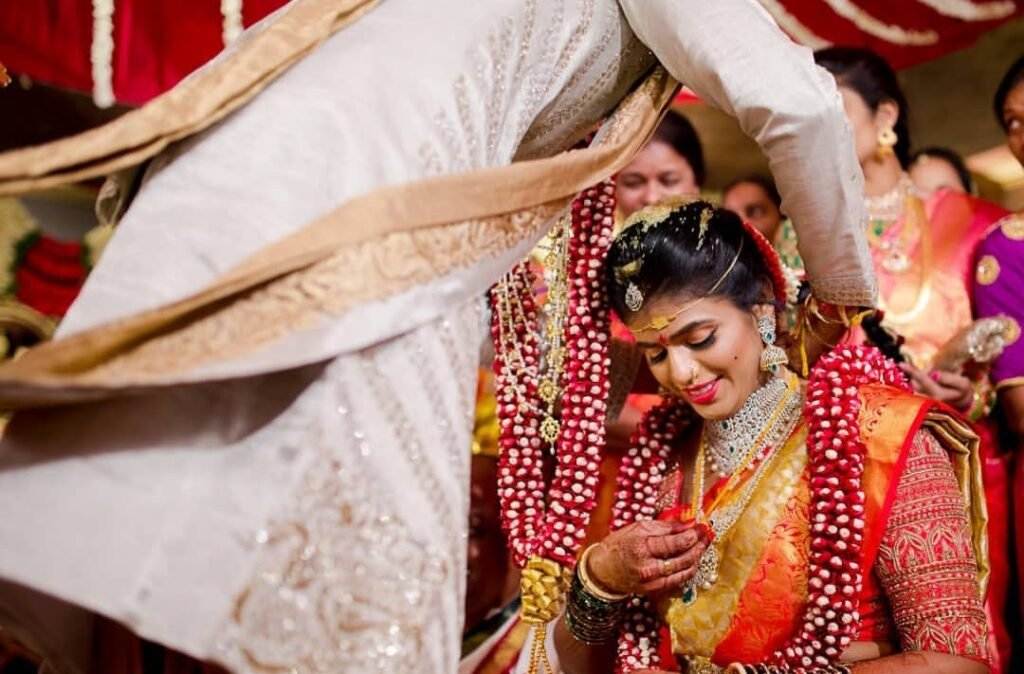
The Mangalsutra, also known as Mangalya Dharane or Thali Kettu, is one of the most significant rituals in a South Indian wedding. The groom ties a sacred necklace around the bride’s neck, signifying their marital bond. The Mangalsutra typically consists of two or three knots.
The first two knots, tied by the groom, symbolize the couple’s commitment to each other and their families. The third knot, tied by a female family member of the groom, signifies the family’s commitment to supporting the union. This necklace is a symbol of marital status and is worn by the bride throughout her married life.
Post-Wedding Rituals
Sadya
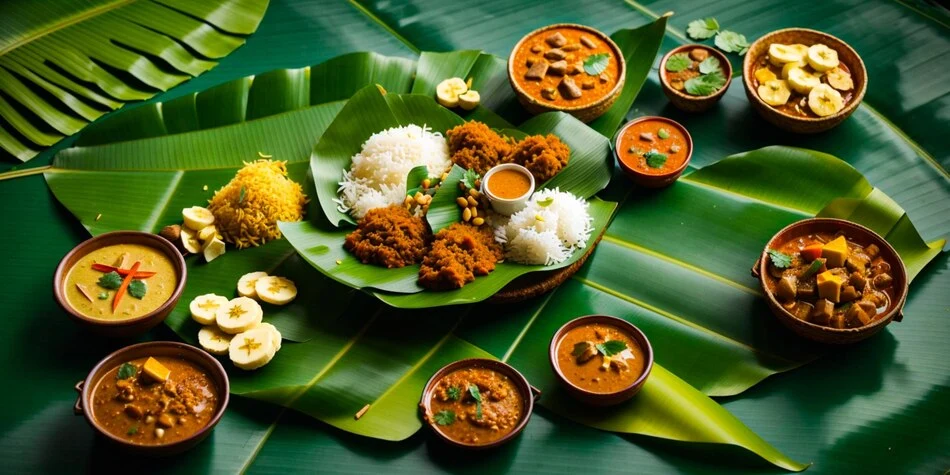
The wedding festivities culminate in a grand feast, known as the Sadya in Kerala or Yele Oota in Karnataka. This traditional meal is served on a banana leaf and includes a variety of dishes that reflect the region’s culinary heritage.
The feast is a celebration of the union and a way to thank the guests for their presence and blessings. It is a colorful and delicious end to the wedding festivities, leaving guests with a memorable experience.
Bidaai
Bidaai is the emotional farewell where the bride leaves her parental home to start her new life with her husband.
It is a poignant moment filled with tears and well-wishes, symbolizing the bride’s departure from her family and her transition to her new role as a wife and daughter-in-law.
This ceremony underscores the bittersweet nature of weddings, where joy and sorrow coexist.
Diverse Regional Traditions
South India is home to a diverse array of cultures, each with its unique wedding customs. While the core rituals remain similar, variations exist across different communities.
Kannada Weddings
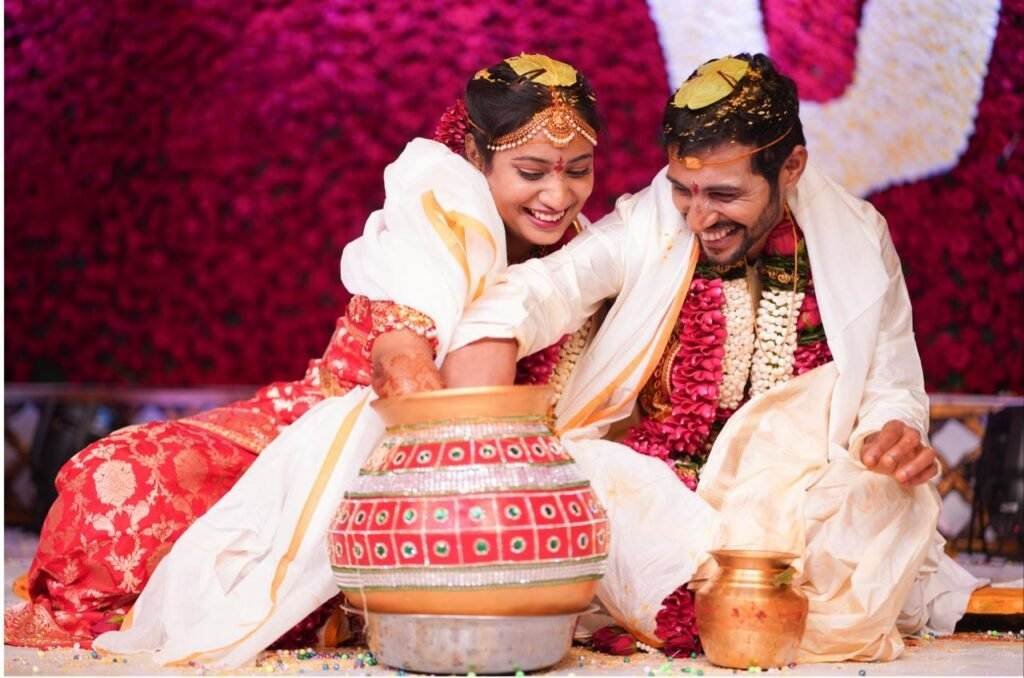
Kannada weddings often include the Dev Karya ceremony, where the groom’s family prays to Lord Ganesha before departing for the wedding venue.
Another unique tradition is the Kashi Yatra, where the groom, dressed in traditional attire, pretends to leave for Kashi to renounce worldly life, only to be persuaded by his maternal uncle to return and marry.
Tamil Weddings
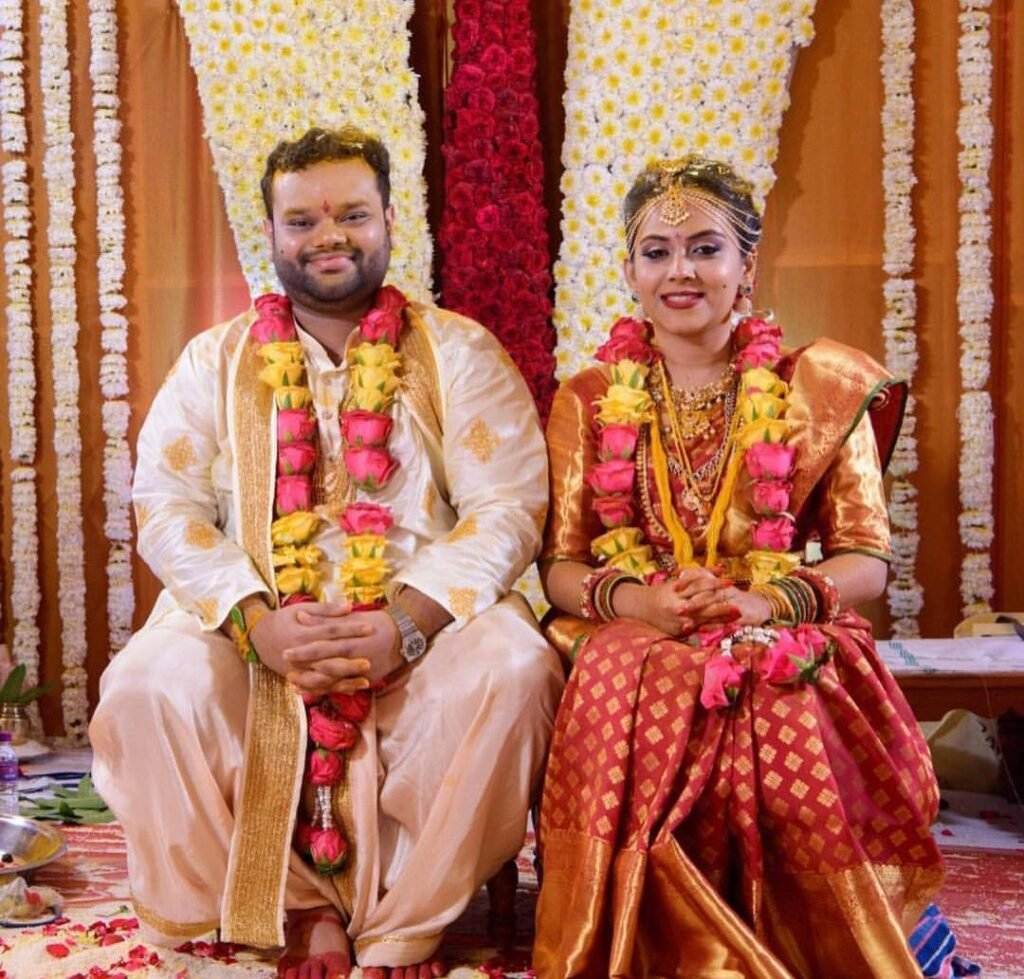
Tamil weddings are known for their simplicity and adherence to rituals. Apart from the main ceremonies, Tamil weddings include the Pallikal Thellichal, where seven earthen pots filled with curd and grains are immersed in water to seek blessings from fish, symbolizing fertility and abundance. The Oonjal ceremony and the Mangala Snanam are also integral parts of Tamil weddings.
Telugu Weddings
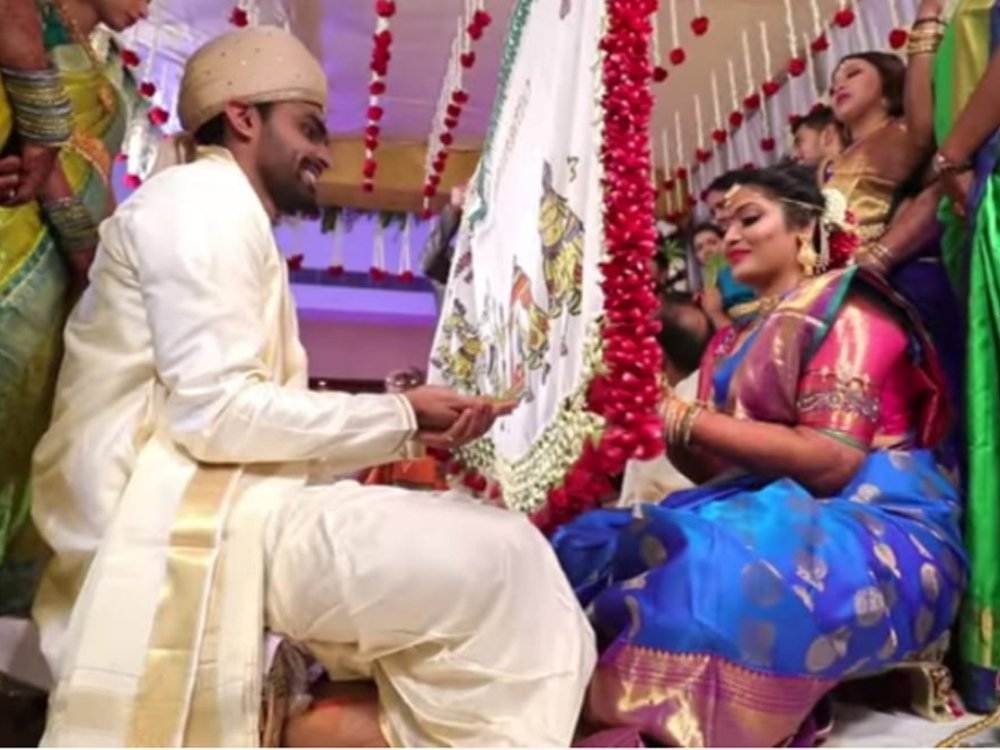
In Telugu wedding rituals, the bride and groom are separated by a curtain during initial rituals, symbolizing the sanctity and purity of the ceremony.
The curtain is removed during the Mangalsutra ceremony, followed by the exchange of garlands and the ritual of Saptapadi.
Another unique ritual is the Talambralu, where the couple showers each other with rice mixed with turmeric and saffron, symbolizing prosperity and happiness.
Malayalee Weddings

Malayalee weddings are marked by their simplicity and elegance. The bride and groom receive blessings from elders before heading to the wedding venue.
The bride’s brother washes the groom’s feet, and the couple exchange garlands and the Mangalsutra. The wedding feast, or Sadhya, is an elaborate affair with a variety of traditional dishes served on a banana leaf.
Ending Note
In conclusion, South Indian weddings are a beautiful mix of love, tradition, and family. From the careful planning of the Muhurtham to the tying of the Mangalsutra, every ritual has a special meaning.
These weddings are not just about two people coming together, but also about families and communities joining in celebration. Each South Indian wedding tradition, whether it’s the fun of Kashi Yatra or the heartfelt Kanyadana, shows the deep cultural values of South Indian society.
Even as times change, these South Indian wedding traditions continue to connect generations and create lasting memories.
FAQs
How long do South Indian wedding ceremonies typically last?
South Indian weddings can span several days, typically lasting from three to five days. This includes pre-wedding rituals, the main wedding ceremony, and post-wedding celebrations. Each day is filled with various traditional ceremonies, cultural events, and festive meals.
What type of attire is traditionally worn by the bride and groom in a South Indian wedding?
The bride typically wears a silk saree, often in bright colors like red, gold, or green, adorned with intricate wedding jewelry and flowers in her hair with traditional South Indian hairstyles. The groom usually wears a dhoti or a traditional silk veshti paired with a kurta or Angavastram. Both attires are chosen for their auspiciousness and cultural significance.
How do families in South Indian weddings incorporate modern elements into traditional ceremonies?
Many South Indian weddings today blend traditional rituals with modern elements. This can include contemporary music and dance performances at the reception, customized wedding invitations, professional photography and videography, and sometimes even destination weddings. These additions make the ceremonies more personal and reflective of the couple’s tastes.


